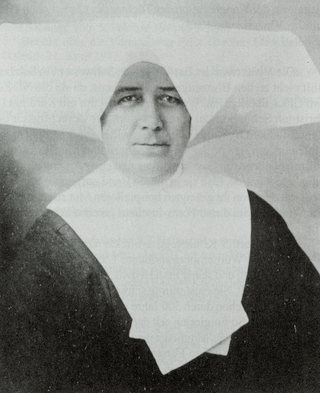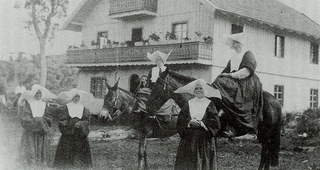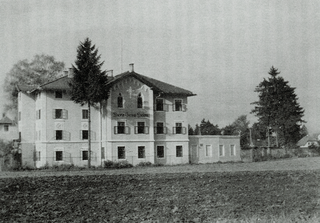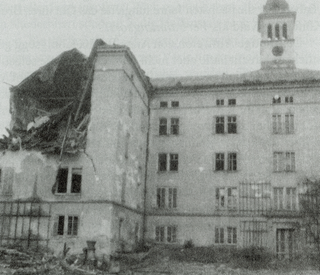Gräfin Anna Bertha von Königsegg BHS

Personalia
Born:
Died:
Profession:
Persecution:
Imprisonment 17.09.1940 - 28.09.1940,
Imprisonment 16.04.1941 - 13.08.1941,
Gau ban 1941
Curriculum Vitae
Anna Bertha von Königsegg was born the eldest daughter of Count Franz Xaver von Königsegg and his wife Hedwig, née von Neipperg, in Königsegg in Württemberg, Germany. The family belonged to the Swabian aristocracy, which maintained close ties with Salzburg for over 300 years. From the middle of the 16th century, six members of the family served as canons in Salzburg.
Anna Bertha von Königsegg grew up in a religious and charitable atmosphere and received a good education, typical of the nobility of the time, with particular emphasis on learning foreign languages. She became fluent in English, French and Italian.
With the outbreak of the First World War in 1914, Anna Bertha von Königsegg had to leave France and was transferred to Turin. In 1916 she went to Siena and returned to Turin in 1919. She then became a business and teaching nurse in the San Vito branch of the city hospital. Finally, in 1925, Anna Bertha von Königsegg became Visitator of the Salzburg Province.

I have made detailed enquiries with the relevant authorities and inform you of the following, which you can follow with a clear conscience and thus comply with the new state regulations as dutiful and honest citizens:
The greeting "Heil Hitler" is mandatory in offices etc., but not on the street and in private traffic. Combine it with the opinion to wish the Führer God's blessing so that he can fulfill his responsible office for the best of the people. If you are invited to listen to the radio, apologize, as you have never done so and, by the way, know nothing about politics and devote yourself entirely to your poor.
The school nurses can take the oath of office with a clear conscience. It contains nothing against our religious convictions, and by the way, an oath can never oblige us to do anything against our conscience, just like the vow of obedience, then the binding nature of the oath ceases. I think I can reassure you with these lines [...]

However, the order's own hospitals were also successively taken over by the National Socialists, the clerical nurses were dismissed and replaced by NSV nurses. For example, the hospital in Kufstein on April 15, 1939 and the hospital in Wörgl on January 1, 1940. At the same time, the NSDAP launched a campaign accusing the Sisters of Mercy of using methods of soul extortion worthy of the practices of the medieval Inquisition.
[It is forbidden to participate in such operations] by assisting, instrumenting (preparing and adjusting instruments) and anaesthetizing. Sick patients may also not be prepared for operations and transferred to the operating theater. Only if nurses are called in to avert an acute danger to life that has suddenly arisen may they respond to this call.
Thanks to this directive, the Sisters of Mercy managed to stay completely out of the National Socialist forced sterilizations without suffering any disadvantage as a result. The predominantly Catholic medical profession tended to be somewhat lenient towards the nuns, especially as they were a very important source of support in the hospitals.
The headmistress of the Schernberg care institution near Schwarzach - St. Veit recently received a message, which she passed on to me as her superior, that sick people from the institution were being collected in collective transports and transferred to other institutions. It is now an open secret what fate awaits these deported patients, because all too often, shortly after their transfer, many of them receive news of their deaths. Consider, Mr. Reichsverteidigungskommissar, the consequences of this procedure: our victorious returning warriors, who have risked blood and life for the fatherland, will perhaps no longer find their father or mother or any other close relative; how will they feel about this?
And does it not cause great unrest and uncertainty among the people, who now more than ever should stand united and trusting, when everyone has to say to themselves: "What will happen to me?" Because every one of us, including you and me, will one day be in need of help or will no longer be able to actively serve the community due to illness or accident. And what will foreign countries think of us if such a high-ranking cultural nation, which has achieved the greatest victories in world history, begins to mutilate itself in the midst of its victorious run?
In response to this letter, Anna Bertha von Königsegg was summoned by the Gestapo on September 17, 1940. During interrogations, the Gestapo wanted to know who had given her the information about the euthanasia program. As she does not disclose this information, she remains in custody until September 28, 1940. After that, the patients were initially housed in the Schernberg care home at the expense of the order.
In my letter of August 23, 1940, no. 51, I took the liberty of commenting on the advance notification of the transfer of inmates from our Schernberg care institution. I now see that the same order is to be expected for our institution in Mariatal near Kramsach (Tyrol). In order to offer a positive solution here too, I declare, as in my above-mentioned letter, that I am prepared to maintain the patients in Mariatal at our expense until peace returns, if I am given the assurance that the patients will be left with us.
Although there is no immediate response to this letter, Anna Bertha von Königsegg is alarmed. She feared that the National Socialists would dissolve the convent and confiscate her assets. She therefore instructed all sisters over the age of 50 to open savings accounts that could be declared as private property in an emergency.
About two months later, the National Socialist regime struck back. On April 11, 1941, Anna Bertha von Königsegg was informed that the removal of the patients from the Schernberg asylum was now imminent. Once again, Anna Bertha von Königsegg wrote to the Gauleiter. On April 15, 1941, the Gestapo sent two officers to the Salzburg Central Hospital to arrest Anna Bertha von Königsegg. However, she was currently on a visit to Kirchbichl in Tyrol. Although she can still be warned of the impending arrest, Anna Bertha von Königsegg refuses to flee and awaits her captors.
On April 16, 1941, Anna Bertha von Königsegg was arrested by the Gestapo in Kirchbichl and taken to Salzburg by car. On the same day, 68 patients were transported from the Salzburg State Sanatorium. The Schernberg asylum was emptied in transports on April 21, 1941, May 20, 1941 and August 4, 1941, and the Mariatal asylum was emptied on May 23, 1941. The patients were sent to the National Socialist euthanasia program.
Anna Bertha von Königsegg was released from prison on 13 August 1941, but was banned from the Gau. She moves to her brother's estate in Königswaldegg. The entire assets of the Sisters of Mercy in Salzburg are confiscated for hostility to the people and the state.

So the Schernberg asylum can be reopened in 1946. In the middle of the reconstruction work, an illness from 1941 that was thought to have been overcome makes itself felt again. Operations and radiotherapy could no longer help. Anna Bertha von Königsegg died in Salzburg on December 12, 1948.
Places
Place of activity:
Citations
- Mikrut, Jan (2000): Blutzeugen des Glaubens. Martyrologium des 20. Jahrhunderts. Band 3 (Wien), p. 221–244.
